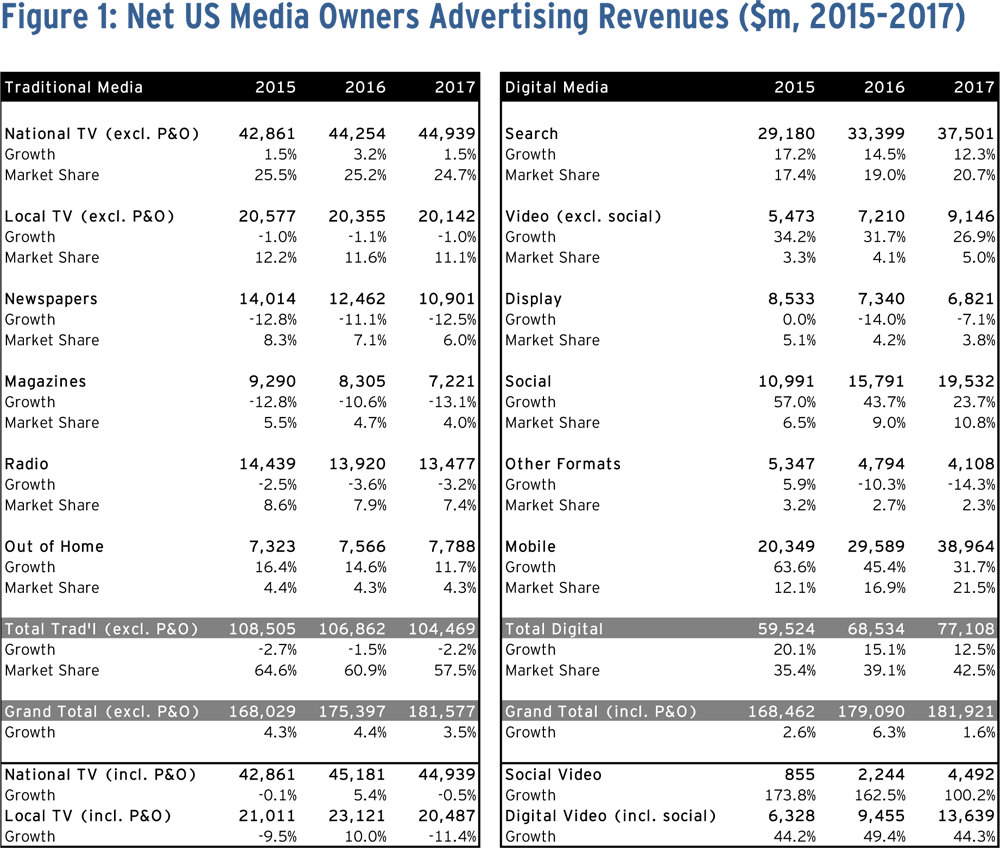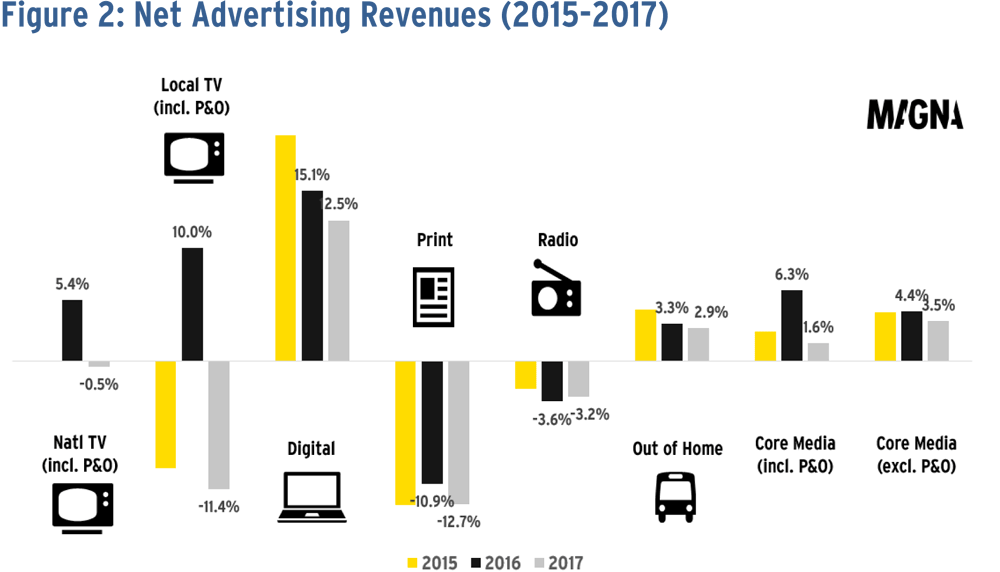US Ad Spend Revenues Increase
October 15, 2016
![]()
1.In its fall forecast published October 3, MAGNA predicts that media owners net advertising revenues will grow by +6.3% to $179 billion this year, the strongest growth rate since 2010.
2.This is marginally above our previous forecast (+6.2% published in June 2016) following a strong first half and despite lower political ad spend expectations.
3.Without the incremental ad sales generated by Political and Olympics ad spend ($3bn and $700m resp.), ad market growth would be +4.4% this year and will
slow down to +3.5% in 2017.
4.Digital media ad sales will grow by +15% this year and +12% next year, whiletraditional media ad sales will decrease by -1.5% this year and -2.2% next year.
5.This yeardigital advertising sales will equal TV ad dollarsfor the first time with both generating $68 billion, a market share of 38.5%.
6.Digital ad sales will then reach $105 billion by 2020, a 51% market share.
7.The main driver this year is social media (+44% to nearly $16bn), ahead of digital video (+32%).
8.Social video ad formats will attract$2.2bnof ad dollars this year i.e. 14% of total social media ad sales, and 24% of total digital video ad sales.
9.National TV is resilient. Ad sales grew +4.6% in the first half thanks to strong pricing offsetting the continued erosion of ratings. Full year ad revenues will grow by +3.2% (excl. P&O), slowing down to +1.5% next year.
Media owners advertising sales are expected to increase by +6.3% in 2016 and by +1.6% in 2017. Neutralizing the impact of incremental ad spend driven by even-year events over the period 2015-2017 (“Political & Olympic” effect or “P&O”) advertising sales would increase by +4.4% in 2016 (previously: +4.1%) and by+3.5% in 2017 (prev. +3.4%).
Media vendor advertising sales were strong in the first half of the year (+6.1% overall, excl. P&O), arguably over a weak 2015 period. Ad sales were driven by national TV (+4.6%), digital media (+18.3%) and Out-Of-Home media (OOH) (+3.8%) while the advertising sales of print and radio decreased (-9% and -2% respectively).
Looking at individual media categories, the +6.3% growth overall for 2016 will be almost entirely driven by digital media (+15% to $68bn) and television (+6.9% to $68bn) while print media and radio advertising sales will continue to decline (newspapers -11% to $12bn, magazines
-11% to $8bn, radio -4% to $14bn). Meanwhile OOH media, including cinema, will grow by +4% to $7.5bn. Consolidating all traditional media categories (TV, print, radio, OOH), ad sales will decrease by -1.5% this year to $107bn and by another -2.2% next year.
National Television advertising sales grew steadily, by +4.6% (excl. P&O), in the first half of the year. This compares to a –
0.5% decline for the same period last year. We expect lower growth in the second half, mostly due to stronger comps, but we have increased the full-year 2016 growth expectation to +3.2% excl. P&O.
The current strength of pricing is likely caused by television ratings erosion having reached a tipping point.
Many big brands in mainstream consumer verticals (CPG, food, entertainment etc.), traditionally heavy on national television, have been willing to tolerate higher levels of inflation than before, in order to secure their share of a shrinking supply of traditional linear national television ratings, deemed essential to their business model . Some of those advertisers do not perceive the alternatives to national TV (e.g. the various forms of digital video) as not sufficient or not appropriate yet. However we believe that those alternatives will gradually become more attractive due to better trading mechanisms, better cross-screen measurement and planning. The deal between MAGNA and Google announced earlier this year was the first-ever TV-style deal between a major agency group and a major digital video provider aimed at making “Google Preferred” YouTube inventory a workable complement or alternative to the shrinking national television inventory, for volume and reach.
Looking at national TV segments, cable networks ad revenues will grow +3.9% to reach $26bn in ad sales this year; English-Speaking broadcast networks will grow ad revenues by +8% to $15bn, including an estimated $700 million derived from incremental Olympic sales (excluding Olympics: +2.2%). Spanish-Language networks ad sales will grow by +8.5%, in great part due to the incremental sales generated by Copa America, the first-ever Pan-American soccer tournament hosted by the US. For 2017 we anticipate supply to continue shrinking and pricing to remain dynamic. In 2017, total national TV ad sales will grow again, by +1.5%, to $45 billion.
Local television is facing a similar ratings erosion as national TV but it does not experience a similar pricing surge as a result, because of weaker underlying demand. Excluding political ad sales, local TV ad sales would be down -1% this year to $20 billion. The good news for local stations is that they maintain dominant in political advertising, far above other traditional local media (print, radio, OOH) and despite the rise of digital. Adding an estimated $2.8 billion in incremental political ad sales this year (+3% vs 2012), total local TV ad sales should grow by +10% this year, but decrease by -11% next year, showing no real impetus beyond the cyclical political bonanza.
Digital media advertising salesare forecast to grow by 15% this year to reach $68 billion. Growth is entirely driven by mobile-based impressions (+45%) while desktop-based impression generate stagnating ad sales (-0.6%). In terms of formats, video and social continue to show explosive growth (+32% and +44% respectively) while search will grow by a robust 14%. Meanwhile, static display banners will start to attract fewer dollars due to lower demand and ad blocking.
As predicted by MAGNA for the last two years, 2016 is the year when digital media ad sales finally equal television ad sales making digital media the #1 category, as the curves cross each other at $68.5bn or 38% market share. From that point, digital media will grow to $105 billion by 2020, a 51% market share.The biggest driver to digital media this year has been social video, with ad sales predicted to reach $2.2bn, which already represents 14% of total social media sales and 24% of total video formats ad sales. Social video is particularly attractive to TV-centric brands that were spending very little with paid social format until now, but are eager to complement shrinking reach of their television campaign.





























